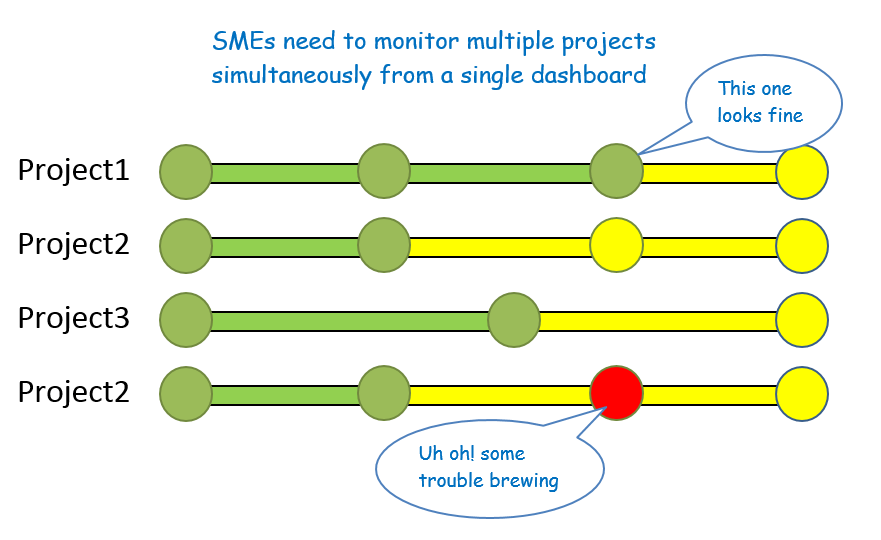The solar power industry has been on an upswing over the recent years. As the PV panel costs have decreased, many utility scale mega solar projects have sprung across different geographies globally. In the continuation of that same trend, distributed solar power generation on rooftops has also started to make good economic sense.
This has led to the formation of many localized rooftop solar installation businesses. Most of the local rooftop solar panel installers are SMEs, executing a large number of small scale projects (1kW – 100kW) on roofs of residential or commercial buildings.
Although the rooftop and utility scale solar installers operate in the same solar power industry, their businesses are quite different as far as project execution is concerned.
For a localized rooftop solar business, it is important to identify how their projects are different. And accordingly, they can set up their project execution practices and decide on which project management tools to use.
Many small projects to be tracked
Rooftop solar installers rely on executing many projects of smaller kW scale capacity.
Whereas utility solar project managers are concerned with managing 1-2 large solar projects at a given time, a rooftop solar project manager has to monitor 10-15 running simultaneously. All of these may be running at different locations.
So a rooftop solar project manager would want tools that provide him high level visibility of what’s happening in these 15 projects, but alert him only in case any problem occurs in any of these 15 projects.

So that he can focus on troubleshooting that one problem, instead of investigating each project in great detail every day.
Scale and team size
Large utility scale solar project contractors typically execute MW scale projects and their project teams have even up to 50-100 team members from different functions.
Most rooftop solar businesses execute large number small scale rooftop solar panel installation projects. Project team size for smaller kW scale is often between 5-10 team members.
For smaller teams, communication is done on a more personal level. Responsibilities are clearly assigned to specific individuals and not to roles. Communication can be more direct and in fact easier when you are working in a smaller team.
On the other hand, smaller rooftop projects have a fast tracked schedule. Hence the faster and direct communication is a necessity for smaller rooftop solar projects.
Tracking the details
A mega utility scale project has a large scope of work (SOW), a complex project schedule and multiple levels of team hierarchy. But sometimes even a small activity from this large SOW can turn prove to be a bottleneck which can cause the project to be delayed.
Considering the costs of delaying a large project, the project manager would want to have detailed visibility with daily/weekly status reports of critical path activities. These reports have to be prepared by gathering data from multiple levels of project team hierarchy.
However, a rooftop solar installer does not need to worry about such detailed tracking of projects. Rather he would be happy with a platform providing high level visibility of multiple projects in real time.
Procedures vs Flexibility
Design and construction of a mega solar power plant needs to be executed by a large team. To properly control this team and the project execution, management has to rely on adherence to standard procedures by the project team.
If the team does not follow certain standard procedures or work practices, there would be chaos.
However, it’s a different matter for small rooftop solar project teams. They communicate directly, have better visibility of what is happening on the ground. Having rigid procedures can actually bog them down. Instead, they need tools to help them in getting the work done. They need tools that are flexible enough for improvisation.
Suitable project management tools
We can then summarize the different requirements of managing rooftop solar projects vs utility solar –
|
Rooftop solar project |
Utility scale solar project |
|
|
We have already compared the pros and cons of different tools for tracking of engineering and construction projects.
This comparison of different tools for project management tools tells us that tools like ERP software, traditional project management software are more suited for tracking and managing large scale complex utility solar projects.
On the other hand, rooftop solar installers need user friendly tools like – shared spreadsheets (like Google drive) or whiteboards. These tools are very easy to use, but they don’t always provide the insights that a project manager is looking for. They are also not the best tools for communication.
Hence our team at WorkPack has combined the other user friendly tools that are already helping millions of other SMEs and put them on a single platform. So we combined – emails, spreadsheets, documents & drawing files with our flexible workflow engine.

This platform has already helped multiple rooftop solar installers to digitalize their work practices and replace white boards with digital dashboard.
Can it also help your team?
Set up a free account for you and your team and find out for yourself. Let us know if you need any help in signing up.


1 Comment
PRASHANT
April 4, 2018
Awesome